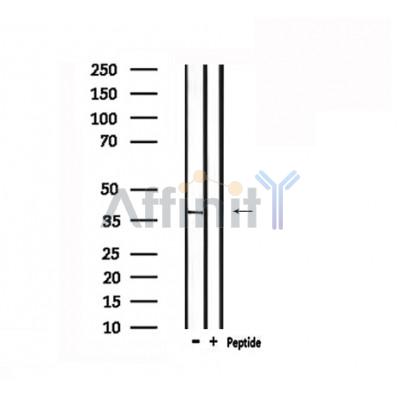BMI1 Antibody - #DF6017
| Product: | BMI1 Antibody |
| Catalog: | DF6017 |
| Description: | Rabbit polyclonal antibody to BMI1 |
| Application: | WB IHC |
| Reactivity: | Human, Mouse, Rat |
| Prediction: | Pig, Bovine, Sheep, Rabbit, Chicken |
| Mol.Wt.: | 37kDa; 37kD(Calculated). |
| Uniprot: | P35226 |
| RRID: | AB_2837992 |
Related Downloads
Protocols
Product Info
*The optimal dilutions should be determined by the end user.
*Tips:
WB: For western blot detection of denatured protein samples. IHC: For immunohistochemical detection of paraffin sections (IHC-p) or frozen sections (IHC-f) of tissue samples. IF/ICC: For immunofluorescence detection of cell samples. ELISA(peptide): For ELISA detection of antigenic peptide.
Cite Format: Affinity Biosciences Cat# DF6017, RRID:AB_2837992.
Fold/Unfold
B lymphoma Mo MLV insertion region (mouse); B lymphoma Mo MLV insertion region 1 homolog; Bmi 1; BMI1; BMI1 polycomb ring finger oncogene; BMI1_HUMAN; Flvi 2/bmi 1; FLVI2/BMI1; MGC12685; Murine leukemia viral (bmi 1) oncogene homolog; Oncogene BMI 1; PCGF 4; PCGF4; Polycomb complex protein BMI 1; Polycomb complex protein BMI-1; Polycomb group protein Bmi1; Polycomb group ring finger 4; Polycomb group RING finger protein 4; RING finger protein 51; RNF 51; RNF51;
Immunogens
A synthesized peptide derived from human BMI1, corresponding to a region within the internal amino acids.
- P35226 BMI1_HUMAN:
- Protein BLAST With
- NCBI/
- ExPASy/
- Uniprot
MHRTTRIKITELNPHLMCVLCGGYFIDATTIIECLHSFCKTCIVRYLETSKYCPICDVQVHKTRPLLNIRSDKTLQDIVYKLVPGLFKNEMKRRRDFYAAHPSADAANGSNEDRGEVADEDKRIITDDEIISLSIEFFDQNRLDRKVNKDKEKSKEEVNDKRYLRCPAAMTVMHLRKFLRSKMDIPNTFQIDVMYEEEPLKDYYTLMDIAYIYTWRRNGPLPLKYRVRPTCKRMKISHQRDGLTNAGELESDSGSDKANSPAGGIPSTSSCLPSPSTPVQSPHPQFPHISSTMNGTSNSPSGNHQSSFANRPRKSSVNGSSATSSG
Predictions
Score>80(red) has high confidence and is suggested to be used for WB detection. *The prediction model is mainly based on the alignment of immunogen sequences, the results are for reference only, not as the basis of quality assurance.
High(score>80) Medium(80>score>50) Low(score<50) No confidence
Research Backgrounds
Component of a Polycomb group (PcG) multiprotein PRC1-like complex, a complex class required to maintain the transcriptionally repressive state of many genes, including Hox genes, throughout development. PcG PRC1 complex acts via chromatin remodeling and modification of histones; it mediates monoubiquitination of histone H2A 'Lys-119', rendering chromatin heritably changed in its expressibility. The complex composed of RNF2, UB2D3 and BMI1 binds nucleosomes, and has activity only with nucleosomal histone H2A. In the PRC1-like complex, regulates the E3 ubiquitin-protein ligase activity of RNF2/RING2.
Monoubiquitinated (By similarity). May be polyubiquitinated; which does not lead to proteasomal degradation.
Nucleus. Cytoplasm.
Research Fields
· Cellular Processes > Cellular community - eukaryotes > Signaling pathways regulating pluripotency of stem cells. (View pathway)
· Human Diseases > Cancers: Overview > Transcriptional misregulation in cancer.
· Human Diseases > Cancers: Overview > MicroRNAs in cancer.
References
Restrictive clause
Affinity Biosciences tests all products strictly. Citations are provided as a resource for additional applications that have not been validated by Affinity Biosciences. Please choose the appropriate format for each application and consult Materials and Methods sections for additional details about the use of any product in these publications.
For Research Use Only.
Not for use in diagnostic or therapeutic procedures. Not for resale. Not for distribution without written consent. Affinity Biosciences will not be held responsible for patent infringement or other violations that may occur with the use of our products. Affinity Biosciences, Affinity Biosciences Logo and all other trademarks are the property of Affinity Biosciences LTD.


